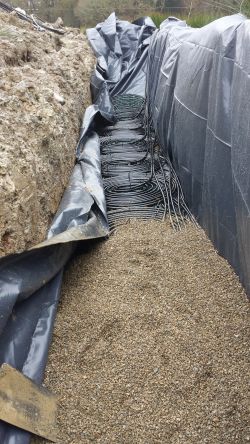Surface water, rivers, lakes and spring water source heat pumps
Rules and regulations and the lack of available manufactured equipment have made this type of system less attractive. That said, there may be a increased interest in this method since it can have advantages over other systems if the situation is right.
Springs
Deep ground temperatures approximate to the average air temperature over the year. (e.g. around 8 to 12ºC or 46 to 54ºF in Northern Europe). Ground water and springs are often at this average ground temperature, and sometimes vary negligibly from summer to winter. If you are lucky enough to have one, this is an excellent source of heat for a heat pump. Even in the middle of winter, this system should maintain a very good energy-efficiency. The only pitfall to avoid would be if the spring is lower and a long distance away. If the energy required to pump the spring water to where you need is great, this will detract from the viability of the source.
Only very few heat pumps may be capable of taking spring water directly, and this may in any case be a little risky with respect to fouling or corrosion. A corroded heat-exchanger could result in a VERY expensive repair to the refrigeration circuit. The water purity should be tested to see if is suitable for the heat-exchanger in the heat pump. One option to protect your expensive heat pump is to use an intermediate heat exchanger with a glycol circuit between them. However, this will reduce the energy-efficiency because the heat pump would ‘see’ colder water compared to the direct type, and also an extra circulation pump is needed. 
Another alternative is to use a very large plastic pipe (like a ground source slinky) in a gravel bed with the spring water running across it. This should be a fit-and-forget system and can be extremely efficient. A very large amount of pipes will be need.
The picture shows 8 x 100m loops of 20mm pipe carefully coiled in a gravel ‘envelope’, and this is for a small (6kW output) heat pump. In this case, the pipes are big enough so that no glycol antifreeze is needed.
Rivers and streams
A river or small stream can be utilised, but the water temperature could approach freezing point in mid winter. For direct pumping (open loop), many heat pumps require water at temperatures above 5 to 8°C (varying depending on model). This means that in colder climatic regions, the heat pump may not work in the depth of winter. It is probably most practical to install river source systems in situations where a lot of heat is required, for example in commercial situations. The same water quality constraints and pumping-power issues apply as spring source (above).
Stainless plate collectors or coiled plastic pipes positioned within the river water may be an option, and could be filled with a low-toxicity glycol if local regulations permit. Such systems could operate at slightly colder river temperatures, and could probably be able to operate with some ice build-up on the outside of the collector coils. Attention to the finer details would be imperative here, and permission sought. This does not feel like a fit-and-forget system to me.
Whilst delivering high-efficiencies for most of the year, a system could be in risk of failing to operate completely in the middle of winter during lower temperatures, and this is just when you need the most heat. An alternative back-up heating method will be needed for severe winters.
A recent detailed CIBSE document discusses all the options – Surface water source heat pumps